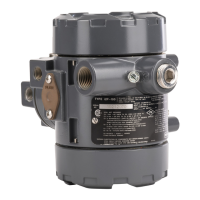Instruction Manual
D103198X012
i2P-100 Transducer
July 2014
17
1. Remove electronics module cover (cover adjacent to conduit entry, see figure 3 and 4).
CAUTION
Do not attempt to remove either of the housing caps if the locking set screws (key 8) are engaged. Removing housing caps
without disengaging the set screws can cause damage to the housing caps.
2. Input and output ranges are selectable by dip switch selection. Refer to figure 10 for dip switch settings. Adjust dip
switch settings and zero and span as necessary to achieve the desired input/output range.
3. If a current source other than the control device is used as the input source, disconnect the control device and
connect the current source positive terminal to the transducer “+” terminal and the current source negative
terminal to the transducer “-” terminal.
If an external meter is used, connect the current source positive terminal to the transducer “+” terminal. Connect
the meter positive terminal to the transducer “-” terminal and the meter negative terminal to the current source
negative terminal as shown in figure 8.
4. Check the supply pressure to ensure it is at the recommended pressure. Refer to table 1, the Specifications table,
for supply pressure recommendations.
5. Adjust the input current to the low mA DC.
6. The output pressure should be 0.2 bar (3 psig). If not, adjust the ZERO potentiometer until the output pressure
is 0.2 bar (3 psig).
7. Adjust the input current to the high mA DC.
8. The output pressure should be 1.0 bar (15 psig). If not, adjust the SPAN potentiometer until the output pressure
is 1.0 bar (15 psig).
9. Repeat steps 5 through 8 until the output pressure is within the referenced accuracy requirements without further
adjustment.
10. If a current source other than the control device was used, disconnect the current source and reconnect the control
device.
Principle of Operation
The converter module receives a standard DC current input signal from a control device to operate coils in a force
balanced beam system which in turn, controls bleed air through an integral nozzle/flapper arrangement. The nozzle
pressure provides the input signal to operate the relay as shown in figure 11. Relay output pressure is applied, through
tubing, directly to the final control element or valve/actuator assembly.

